Cortical screws vs cancellous screws – In the realm of orthopedic surgery, cortical and cancellous screws play pivotal roles in fracture fixation and bone reconstruction. With distinct designs and biomechanical properties, these screws cater to specific clinical scenarios, offering unique advantages and considerations. This comprehensive guide delves into the intricate world of cortical vs cancellous screws, exploring their differences, applications, and surgical techniques, empowering surgeons with the knowledge to make informed decisions for optimal patient outcomes.
Cortical Screws vs Cancellous Screws
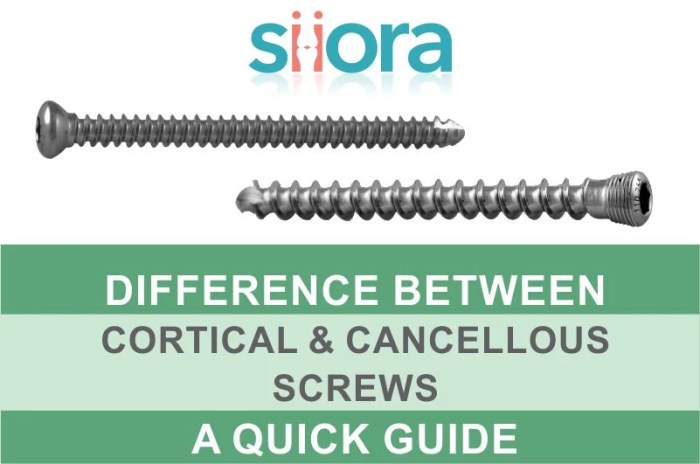
Cortical screws and cancellous screws are two types of screws commonly used in orthopedic surgery to fixate bones. They differ in design and purpose, depending on the type of bone they are used to fixate.Cortical screws are designed to be inserted into the outer layer of bone, known as the cortex.
They have a sharp tip and a coarse thread that allows them to cut through the hard outer layer of bone and provide a secure hold. Cortical screws are typically used to fixate fractures in the long bones of the body, such as the femur, tibia, and humerus.Cancellous
screws, on the other hand, are designed to be inserted into the inner layer of bone, known as the cancellous bone. They have a blunt tip and a fine thread that allows them to engage with the softer cancellous bone and provide a more distributed hold.
Cancellous screws are typically used to fixate fractures in the short bones of the body, such as the vertebrae, pelvis, and hand bones.Each type of screw has its own advantages and disadvantages. Cortical screws provide a more secure hold in hard bone, but they can be more difficult to insert and can cause more damage to the bone.
Cancellous screws are easier to insert and cause less damage to the bone, but they may not provide as secure a hold in hard bone.The choice of which type of screw to use will depend on the specific fracture being treated and the quality of the bone.
In some cases, a combination of cortical and cancellous screws may be used to provide the best possible fixation.
Biomechanics of Cortical and Cancellous Screws
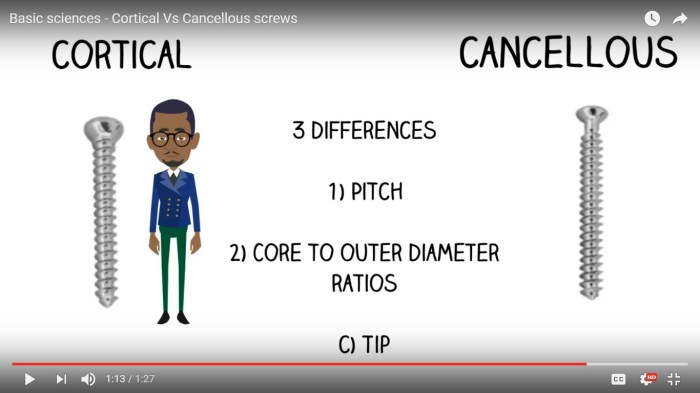
Cortical and cancellous screws exhibit distinct biomechanical properties due to the variations in their structural characteristics and the nature of the bone they engage with.
Biomechanical Properties of Cortical Bone and Cortical Screws
Cortical bone, the dense outer layer of bone, possesses high stiffness and strength, allowing it to withstand significant compressive and tensile forces. Cortical screws are designed with a large diameter and coarse threads to maximize their engagement with the dense cortical bone.
This design provides superior resistance to pull-out and shear forces.
Biomechanical Properties of Cancellous Bone and Cancellous Screws
Cancellous bone, the porous inner layer of bone, has a lower density and strength compared to cortical bone. It is composed of a network of interconnected trabeculae, which provide support and absorb shock. Cancellous screws are typically smaller in diameter and have finer threads to optimize their interaction with the trabecular structure of cancellous bone.
This design allows for greater surface area contact and improved load distribution.
Comparison of Biomechanical Strength
Studies have demonstrated that cortical screws generally exhibit higher pull-out strength and shear strength compared to cancellous screws. This is attributed to the denser structure of cortical bone and the larger diameter and coarse threads of cortical screws. However, cancellous screws may provide better resistance to bending and fatigue loading due to their smaller size and finer threads, which allow for more flexibility.
Surgical Techniques for Cortical and Cancellous Screws
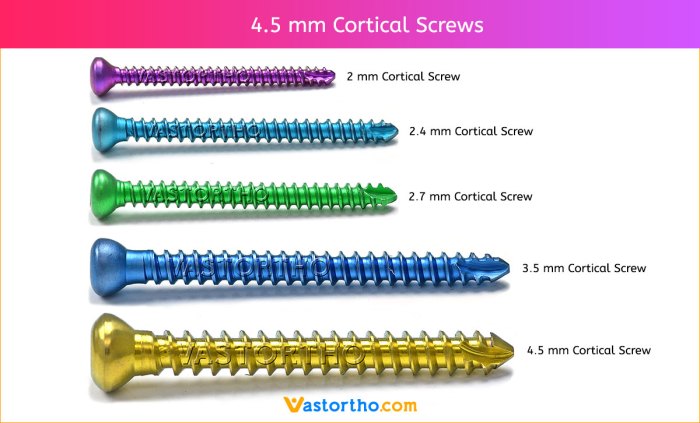
Surgical techniques for cortical and cancellous screws differ based on the specific anatomy and bone quality. The following table compares the key aspects of surgical techniques for both types of screws:
| Cortical Screws | Cancellous Screws | |
|---|---|---|
| Screw Placement | Inserts into the dense outer layer of bone, providing strong fixation | Inserts into the porous inner layer of bone, providing a more secure hold in weaker bone |
| Instrumentation | Requires specialized instrumentation, including a drill, tap, and screwdriver | Can be inserted using a variety of techniques, including hand insertion or with power tools |
| Potential Complications | Screw loosening or breakage due to excessive force or poor bone quality | Screw migration or breakage due to inadequate bone density or improper insertion technique |
Cortical screws are typically inserted using a drill to create a pilot hole, followed by a tap to thread the hole and a screwdriver to insert the screw. Cancellous screws can be inserted using a variety of techniques, including hand insertion or with power tools.
The choice of technique depends on the specific screw design and the surgeon’s preference.
It is important to note that the surgical technique should be tailored to the individual patient and the specific clinical situation. Proper surgical technique is essential to ensure optimal outcomes and minimize the risk of complications.
Clinical Applications of Cortical and Cancellous Screws
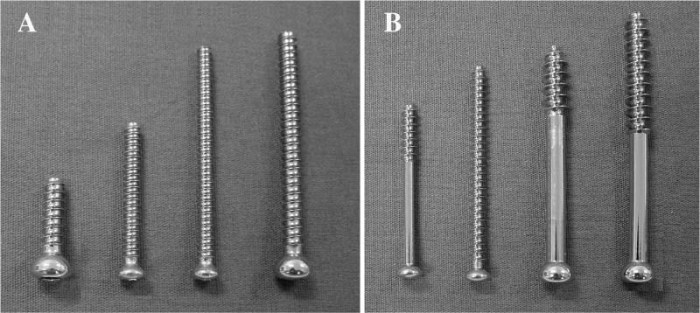
Cortical and cancellous screws are both commonly used in orthopedic surgery to fixate bone fragments and provide stability to injured or diseased bone. The choice of screw type depends on several factors, including the fracture type, bone density, and patient factors.
Fracture Type
- Cortical screwsare typically used for fractures that involve the outer, cortical layer of bone. These screws provide strong fixation and can withstand high loads.
- Cancellous screwsare typically used for fractures that involve the inner, cancellous layer of bone. These screws provide less rigid fixation but are better suited for fractures in osteoporotic bone.
Bone Density, Cortical screws vs cancellous screws
- Cortical screwsare better suited for use in dense bone, such as the diaphysis of long bones.
- Cancellous screwsare better suited for use in osteoporotic bone, such as the metaphysis of long bones or the vertebral bodies.
Patient Factors
- Age: Cortical screws are typically used in younger patients with healthy bone.
- Bone quality: Cancellous screws are better suited for patients with osteoporotic bone.
- Activity level: Cortical screws are better suited for patients who are active and require strong fixation.
Complications Associated with Cortical and Cancellous Screws
Cortical and cancellous screws are commonly used in orthopedic surgeries to fixate bone fragments and provide stability. However, like any surgical procedure, the use of these screws carries potential risks and complications.
Potential Complications
- Screw loosening: This is the most common complication associated with cortical and cancellous screws, occurring in approximately 5-10% of cases. It occurs when the screw loses its grip on the bone, leading to instability and pain.
- Screw breakage: Screw breakage is a rare but serious complication, with an incidence rate of less than 1%. It can occur due to excessive stress or fatigue on the screw.
- Infection: Infection is a potential complication of any surgical procedure, including the use of cortical and cancellous screws. It can occur if bacteria enter the surgical site and cause an infection in the bone or surrounding tissues.
- Nerve damage: Nerve damage is a rare complication that can occur if a screw is placed too close to a nerve.
This can lead to numbness, tingling, or pain in the affected area.
- Vascular injury: Vascular injury is another rare complication that can occur if a screw is placed too close to a blood vessel. This can lead to bleeding or damage to the blood vessel.
Prevention and Management
To prevent and manage complications associated with cortical and cancellous screws, several strategies can be employed:
- Proper surgical technique: Using the correct surgical technique is crucial to minimize the risk of complications. This includes selecting the appropriate screw size and type, using proper insertion techniques, and ensuring adequate fixation.
- Patient selection: Careful patient selection is important to identify individuals who may be at higher risk for complications.
This includes considering factors such as bone quality, medical conditions, and smoking status.
- Post-operative care: Following surgery, patients should follow their doctor’s instructions carefully to minimize the risk of complications. This includes avoiding strenuous activity, keeping the surgical site clean, and taking antibiotics as prescribed.
- Regular follow-up: Regular follow-up appointments with the doctor are essential to monitor the healing process and identify any potential complications early on.
By following these strategies, surgeons can help to minimize the risk of complications associated with cortical and cancellous screws and improve patient outcomes.
Future Directions in Cortical and Cancellous Screw Research
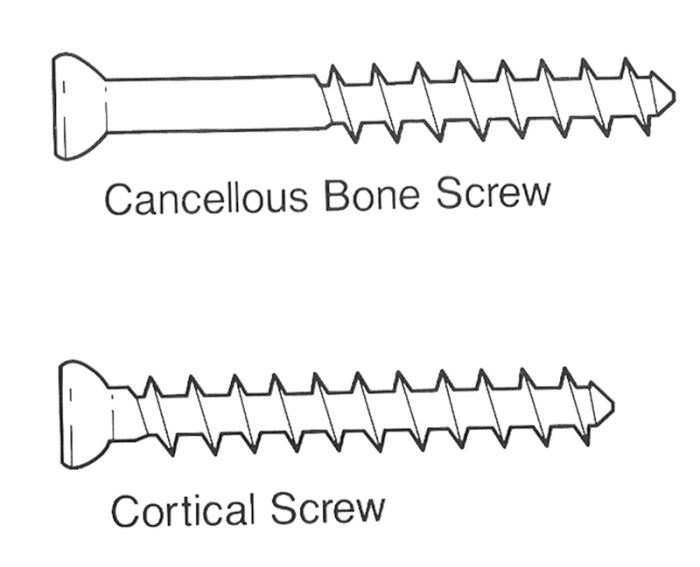
Advancements in screw design and surgical techniques are continuously being explored to enhance the clinical outcomes of orthopedic procedures involving cortical and cancellous bone fixation.
Research efforts are focused on improving screw performance, reducing complications, and personalizing treatment approaches.
Novel Screw Designs and Materials
Researchers are investigating new screw designs, such as variable-pitch threads and optimized thread profiles, to enhance screw stability and minimize bone damage.
Additionally, the development of novel materials, including biodegradable and bioresorbable polymers, is being explored to create screws that can adapt to changing bone conditions and promote bone healing.
Advanced Surgical Techniques
The advent of minimally invasive surgical techniques has led to the development of specialized screws and instrumentation for smaller incisions and reduced surgical trauma.
Robotic-assisted surgery is also gaining traction, offering increased precision and accuracy during screw placement.
Personalized Medicine
Personalized medicine approaches are being applied to screw selection and surgical planning.
3D printing technology allows for the creation of patient-specific screws that match the unique anatomy of the patient, optimizing screw fit and reducing the risk of complications.
FAQ Resource: Cortical Screws Vs Cancellous Screws
What are the primary differences between cortical and cancellous screws?
Cortical screws are designed with a wider thread pitch and larger diameter, providing greater purchase in dense cortical bone. In contrast, cancellous screws feature a narrower thread pitch and smaller diameter, optimizing their grip in softer cancellous bone.
When should cortical screws be used over cancellous screws?
Cortical screws are typically preferred for fractures in dense cortical bone regions, such as the diaphysis of long bones. Their larger diameter and wider thread pitch provide enhanced stability and resistance to pull-out.
What are the potential complications associated with cortical and cancellous screws?
Both cortical and cancellous screws can be associated with complications such as screw breakage, loosening, infection, and damage to surrounding tissues. Careful surgical technique and appropriate screw selection can minimize these risks.